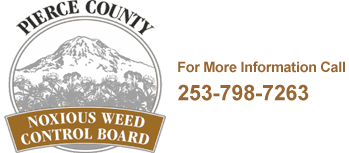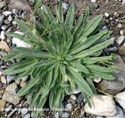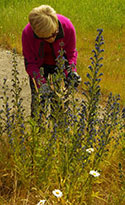Blueweed
Echium vulgare • Class B |
||
| Family Name: | Boraginaceae (Bor-AJ-in-nee-see-ee) | |
| Common: | Forget-me-not family | |
| Genus: |
Echium (ECK-ee-um) Meaning: Greek word for viper, the nutlets resemble a viper's head |
|
| Species: |
vulgare (vul-GAIR-ee) Meaning: Common |
|
| Description: |
Blueweed stems are covered with short, stiff hairs, with dark flecks at the base of some hairs. Its flowering stems grow from 1 to 3 feet tall. Leaves are lance shaped and hairy, becoming smaller and stalk-less as they grow alternately up the stem. Leaves often have dark flecks on the undersides. Plants bloom from June through August; seeds mature about a month after bloom. Bright blue, funnel shaped flowers are arranged on the upper side of the stems. Buds are reddish-purple, becoming bright blue at full bloom. Each plant can produce up to 2,800 seeds that can remain viable in the soil for several years.
|
| Why Is it a Noxious Weed? |
It invades pasturelands, outcompletes desirable vegetation, and is unpalatable to livestock. It is believed to contain several pyrrolizidine alkaloids, which accumulate in the liver and cause liver damage. Skin contact with the bristly hairs of the blueweed may cause dermatitis resulting in inflammation and itching. |
| Where Does it Grow? |
Blueweed does well in a variety of soil types, including poor soils, but does not tolerate shade. It grows on rangeland, rocky pastures, roadsides, waterways, and vacant lots. It is considered unpalatable to livestock because of its coarse hairs and toxic alkaloids. |
| Control Options: |
|
| More Information: |
For more information on this noxious weed Download our Flyer or visit Washington State Noxious Weed Control Board Here. Photo by Leo Michels and Rebecca Shoemaker.
|
| More Pictures: |






 Pierce County Noxious Weed Control Board • 9200 122nd St E, Puyallup, WA 98373 • 253-798-7263
Pierce County Noxious Weed Control Board • 9200 122nd St E, Puyallup, WA 98373 • 253-798-7263